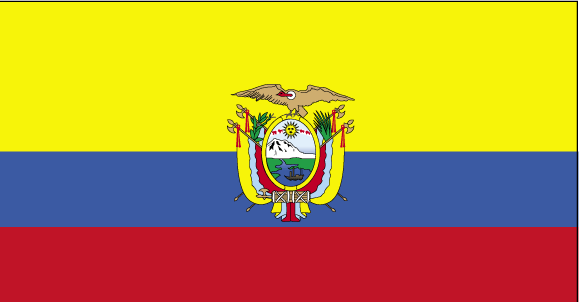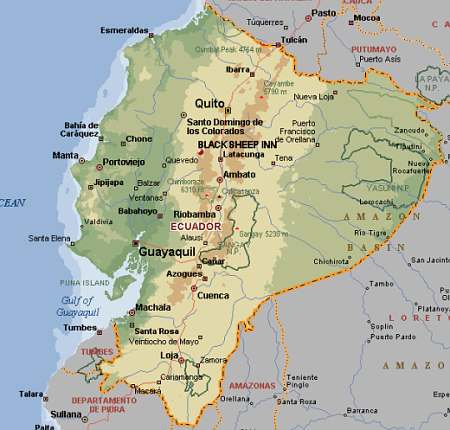|
|
|
NAME: República de
Ecuador
Etymology:
"Ecuador" is the Spanish word for "equator," which passes
through this country.
POPULATION: 16,000,000 (2014)
ETHNIC
GROUPS: Mestizo (65%); Spanish
(7%); African (3%); Amerindian (25%)
CAPITAL: Quito (2,600,000 in
2014); full name: San Francisco de Quito
INDEPENDENCE
DAY: May 24, 1822
LANGUAGES: Spanish (official); Quechua
(unofficial)
RELIGION: Roman Catholic (95%)
LIFE
EXPECTANCY: men (74); women (80)
LITERACY: 91%
GOVERNMENT: Democratic federal republic
ECONOMY: Petroleum, bananas,
flowers, shrimp and fish
MONEY: The same as and
pegged directly to the United States dollar (USD)
GEOGRAPHY: Tropical coast to the Andean
mountain range in the center to the upper Amazon basin in the east.
INTERNET
CODE: .ec
HISTORY:
3500 BCE Various indigenous cultures
1400 CE Cañari culture fell to the Inca empire.
1530 Atahualpa (Inca lord) defeated Huascar
(Inca emperor) and conquered the whole Inca empire for the northern crown of
1531 Pizarro
and Spanish conquistadors defeat the Inca empire.
1563
1809
1822 Battle of Pichincha (near
1830
1895 - 1925 Power
of clergy and conservative land owners reduced under Eloy Alfaro; liberals rule
until revolution of 1925.
1972 A pipeline
constructed that brought petroleum to the west coast for export making Ecuador
South America's second largest oil exporting nation.
(1979-2009 Ecuador had 10 different
presidents.)
2000
2006 Rafael Correa Delgado (American educated economist) elected president: progressive populist leader.
2009 Rafael Correa Delgado re-elected president to four-year term with 51% of the vote. According to Simón Romero reporting for the New York Times (April 27, 2009), Correa combines “nationalistic control of the economy with broadly popular social welfare programs for the poor,” programs that in danger of being reduced ($30 monthly payment to each poor Ecuadorian: see entry for 2000 above) in 2009 due to the falling value of Ecuador’s big export of petroleum.
2017 Lenín Moreno (Lenín Boltaire Morenod Garcés) elected President representing the Alianza PAIS party (Patria Altiva i Soberana [Proud and Sovereign Homeland]. This political party is socialist, humanist and centered on social bases (bases sociales). Moreno is a paraplegic, having been shot in the back in 1999 in a parking lot robbery. In 2012 he won the Nobel Peace Prize for his worldwide advocacy on behalf of the disabled.



